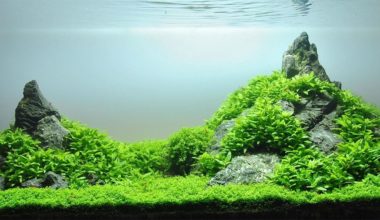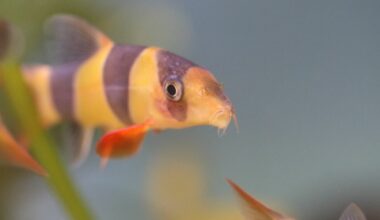
Welcome to the French Angelfish care guide, a widely popular fish among many aquarists that not only has a great personality but it also changes its appearance when it becomes an adult (2 fish in 1).
In this guide you will learn everything you need to properly care for your French Angelfish from diet and tank mates, to tank setup and breeding (don’t forget to check the cool fact about its name).
Join us as we explore the allure of these magnificent creatures and what makes them a prized addition to any marine aquarium.
Quick Facts 
| Scientific Name: | Pomacanthus paru |
| Other Names / Common Species: | French angelfish, French angel, Angelfish, Paru, Chaetodon paru and Indian Fish |
| Reef Safe: | No |
| Lifespan: | 10 to 12 years |
| Size: | 15 inches |
| Care: | Easy |
| Diet: | Omnivores. Shrimp pellets, marine algae, color flakes and chopped seafood |
| Water Parameters: | 72-78°F (22-25.5°C), 8.1-8.4pH, 8-12 dKH, 1.020-1.025 SG |
| Tank Size: | 250 gallons |
| Behavior: | Semi-aggressive especially with other angelfish |
| Breeding: | Medium Difficulty |
Table of Contents
Species Summary
The French Angelfish, also known by its scientific name as Pomacanthus paru, is beloved by aquarists for its regal appearance, hardiness and spirited demeanor. These angelfish are more than just pets; they’re underwater royalty.
Author Note: A cool fact about its name is that if you turn an angelfish sideways, its shape looks similar to the head, wings and dress of an angel. Now you know the origin of its name 😉
In the vast ocean of saltwater favorites, the French Angelfish is found in the Atlantic, the Bahamas and also the Caribbean and the Gulf of Mexico. Like many other saltwater favorites, the French Angelfish is found in the Atlantic Ocean; specifically in the Bahamas and also the Caribbean and the Gulf of Mexico. In the wild you will find this angelfish at depths between 9.8 and 330 ft (3 and 100 meters).
It’s not just an aquatic species; it’s a living piece of art, bringing a touch of the ocean’s majesty right into the homes of enthusiasts.
Appearance
The French Angelfish is a stunning showcase of nature’s artistry. Adorned in a black and gold pattern, their beauty is unparalleled in the aquatic world.
Juveniles vs Adults
Juveniles flaunt a striking lattice of yellow stripes (3-5 to be exact) on a dark background, which gradually transforms into a sophisticated, speckled pattern as they mature. This metamorphosis sets them apart from relatives like the Gray Angelfish.
Author Note: If you are having trouble remembering the transition just think that a striped-juvenile becomes a dotted-adult.
Our buddy the Pomacanthus paru is a fairly large fish that commands attention with its size and the elegance of its long, flowing fins.
The visual transition from juvenile to adult not only reflects their growth but also symbolizes the ever-changing beauty of marine life, making them a fascinating subject for aquarists and marine biologists alike.
Lifespan
The French Angelfish is blessed with a relatively long life, both in the wild and in captivity. In their natural ocean habitats, they can live up to 15 years, a testament to their resilience.
However, in the controlled environment of a home aquarium, the lifespan of French Angelfish typically ranges around 10 to 12 years. This difference is often attributed to various factors like diet, tank conditions, and stress levels.
Who doesn’t love sleeping on their own beds? Similar to people, French Angelfish love environments that closely mimic their natural habitat. If this is coupled with a balanced diet and regular care, their longevity can be significantly enhanced allowing these majestic creatures to thrive for years in your aquatic sanctuary.
Average Size
In the aquatic tapestry of the marine world, these angelfish stand out not just for its beauty but also for its impressive size.
French Angelfish typically reach an average size of 15 inches when fully grown, a size that demands attention in any aquarium setting. Their growth, influenced by factors such as diet, tank conditions, and overall health, is a gradual process.
Author Note: The young version of these guys measures 3 to 4 inches and they are actually helpful to your aquarium by getting rid of parasites from other fish’s bodies. Just don’t get used to it because this stops when they become adults.

French Angelfish Care
The key to the wellbeing of French Angelfish lies in understanding and catering to their unique requirements. This includes ensuring ample space for free movement, maintaining optimal water conditions, and providing a diet that mirrors their natural feeding habits.
Meeting these needs will be the difference between just a tank, and a thriving ecosystem where your French Angelfish can exhibit its natural grace and beauty.
Tank Size
A minimum of 250 gallons is recommended to accommodate the growth of French Angelfish and ensure enough room for comfortable movement. This generous space is not just about luxury; it plays a crucial role in reducing stress, preventing territorial aggression, and promoting healthy growth.
Adequate tank size also aids in maintaining stable water conditions, essential for the long-term health of these sizable marine fish.
Author Note: Let’s not forget that larger tanks are easier to maintain than smaller tanks as we shared in our 75-gallon tank guide.
Water Parameters
- Water temperature: The ideal range is between 72-78°F (22-25.5°C). This tropical temperature supports their metabolic processes.
- pH levels: A stable pH of 8.1-8.4 is crucial, mimicking the alkaline waters of their coral reef homes.
- Water hardness: Aim for a dKH level of 8-12, which helps in maintaining their bone structure and overall health.
- Specific gravity: A range of 1.020-1.025 is optimal, reflecting the salinity of their natural ocean environment.
Tank Setup
Setting up the perfect tank for the French Angelfish involves more than just meeting basic requirements; it’s about creating a slice of the ocean so make sure to stay as close as possible to the points below.
- The substrate should be a fine, soft sand, mimicking the seafloor and providing a comfortable surface for the fish.
- Lighting should be bright enough to illuminate the tank, but not so intense as to cause stress.
- Live rocks are essential, offering natural hiding spots and grazing areas.
- Filtration needs to be efficient to keep the water pristine, yet gentle enough to not create excessive currents.
This setup not only caters to the physical needs of the French Angelfish but also supports their mental wellbeing, providing a habitat where they can express their natural behaviors and flourish.
Are French Angelfish Reef Safe?
Nope, unfortunately French Angelfish are not reef safe. While juveniles generally coexist peacefully with corals, adults may develop a taste for certain soft and stony corals, leading to damage.
If you’re keen on keeping them in a reef tank, consider choosing more resilient coral species, provide plenty of alternative feeding options and monitor their interactions closely.
Common Possible Diseases & Prevention
French Angelfish, like all marine species, are susceptible to certain health issues. Key among these are:
- Marine Ich (White Spot Disease): Characterized by white spots on the skin, lethargy, and rubbing against objects.
- Marine Velvet: A parasitic infection presenting as a yellowish dust on the body, rapid gill movement, and breathing difficulty.
- Bacterial Infections: Often manifesting in sores, ulcers, or abnormal swimming.
Prevention is crucial. This includes maintaining optimal water quality, providing a balanced diet, and ensuring a stress-free environment.
Author Note: Quarantine new additions to the tank to prevent the introduction of diseases. If illness occurs, immediate treatment in a separate quarantine tank, along with specific medications, is critical to prevent spread and aid recovery.
Food & Diet
French Angelfish are omnivores and love a diverse diet of foods like shrimp pellets, marine algae, color flakes and chopped seafood. Given their size, feeding them two to three times daily in small amounts is recommended.
Regular small feedings not only caters to their nutritional needs but also maintains their interest and natural foraging behavior.
Author Note: Mysis shrimp are quite popular because they are a healthy frozen food option and although they are false shrimp, they are bigger than brine shrimp.
Behavior & Temperament
French Angelfish are semi-aggressive, especially towards other angelfish. The Pomacanthus paru can be territorial but are generally peaceful with other species.
As we shared, juvenile french angelfish will provide cleaning services to fish like surgeonfish also known as Tangs and wrasses like the Fairy Wrasse; and as adults they enjoy those services from cleaner shrimp like the peppermint or neon gobies.
Tank Mates
Ideal tank mates include larger fish that can hold their own and that are NOT angelfish like:
- Large Tangs
- Blennies like the Bicolor Blenny
- Triggerfish (the Picasso Triggerfish is one of them)
- Rabbitfish so you can try the Foxface Rabbitfish
- Gobies (we like the Mandarin Goby)
And the ones you should not pair with a french angelfish are those sedentary fish that could be confused with reef rocks like:
- Seahorse
- Frogfish
- Scorpionfish
Author Note: We don’t recommend other angelfish as tank mates, but if you will give it a try then add the peaceful ones first. The eyes of slow moving sharks and stingrays could be picked by French Angelfish so be careful.

Breeding
Breeding French Angelfish in captivity is a complex yet rewarding process which in the wild happens in the summer months. Here’s a step-by-step guide:
- Pair Formation: These fish often form monogamous pairs. Observing and allowing a natural pair to form is crucial which usually happens after they reach about 10 inches.
- Breeding Tank: Set up a separate, quiet tank with optimal water conditions for the breeding pair.
- Spawning Site: Provide a flat surface, like a large rock or slate, where the female can lay her eggs (25,000-75,000 at a time).
- Egg Care: The male typically fertilizes the eggs and both parents guard them, often aerating them for oxygenation.
- Hatching: Eggs usually hatch within 2 to 3 days although it could happen a bit earlier within 15-20 hours after fertilization. Post-hatching, fry care involves feeding with suitable micro-foods like rotifers.
- Growth Monitoring: Regularly monitor the fry’s growth and health, gradually introducing them to standard aquarium conditions.
It is not easy to breed Pomacanthus paru but since there are records of this being done in captivity, you might be able to do it too, so stay positive!
Wrapping Up
So, what do you think? We believe you are ready to care for a French Angelfish! Their large presence and great personality will be a great addition to your saltwater tank and the fact that their appearance changes with time is a plus! Like having two fish in one.
As long as you keep an eye on tank mates and hard corals you will be a happy camper. This is because french angelfish are quite hardy and have a long lifespan. The only minor challenge is space because of the large tank requirements.
We hope you enjoyed reading this guide as much as we enjoyed writing it. Other captivating species include the majestic Lionfish in case you are looking for your next intriguing venture.
Don’t hesitate to reach out with any questions and don’t forget to tag us on Facebook when sharing cool photos of your angelfish. Best of luck!
FAQ
What are the predators of French Angelfish?
Since French Angelfish are already quite big, the only predators will be larger fish like sharks and barracudas.

